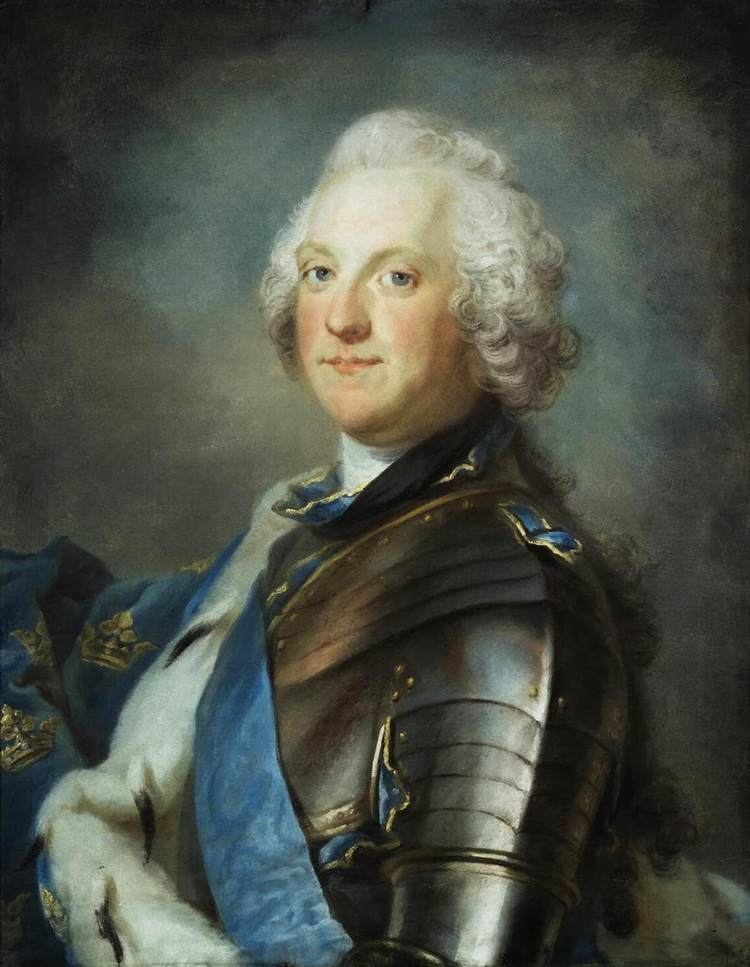Coronation 26 November 1751 Successor Gustav III | Predecessor Frederick I Name Adolf King | |
 | ||
Reign 25 March 1751 – 12 February 1771 Burial 26 February 1771
Riddarholmen Church, Stockholm Issue Gustav III
Charles XIII
Frederick Adolf, Duke of Ostergotland
Sophia Albertina, Abbess of Quedlinburg Died February 12, 1771, Stockholm, Sweden Spouse Louisa Ulrika of Prussia (m. 1744–1771) Children Gustav III of Sweden, Charles XIII of Sweden Parents Christian August of Holstein-Gottorp, Prince of Eutin, Margravine Albertina Frederica of Baden-Durlach Grandchildren Charles XIV John of Sweden, Gustav IV Adolf of Sweden, Carl Lowenhielm, Prince Carl Gustav Similar People Gustav III of Sweden, Louisa Ulrika of Prussia, Charles XIII of Sweden, Frederick I of Sweden, Gustav IV Adolf of Sweden | ||
Adolf Frederick or Adolph Frederick (Swedish: Adolf Fredrik, German: Adolf Friedrich; 14 May 1710 in Gottorp – 12 February 1771, in Stockholm) was King of Sweden from 1751 until his death. He was the son of Christian August of Holstein-Gottorp, Prince of Eutin and Albertina Frederica of Baden-Durlach.
Contents
The first King from the House of Holstein-Gottorp, Adolph Frederick was a weak monarch, instated as first in line of the throne following the parliamentary government's failure to reconquer the Baltic provinces in 1741–43. Asides from a few attempts—supported by pro-absolutist factions among the nobility—to reclaim the absolute monarchy held by former predecessors, he remained a mere constitutional figurehead until his death, by popular belief attributed to a heavy consumption of semlas. His reign saw an extended period of internal peace, although the finances stagnated following failed mercantilist doctrines pursued by the Hat administration ended only in the 1765–66 parliament, where the Cap opposition overtook the government and enacted reforms towards greater economic liberalism as well as a Freedom of Press Act almost unique at the time for its curtailing of all censorship, retaining punitive measures only for libeling the monarch or the Lutheran state church.
Following his death, his son Gustav III seized power in 1772 in a military coup d'etat, reinstating absolute rule.
Ancestry
His father was Christian Augustus (1673–1726) duke and a younger prince of Schleswig-Holstein-Gottorp, prince-bishop of Lubeck, and administrator, during the Great Northern War, of the duchies of Holstein-Gottorp for his relative Charles Frederick. His mother was Albertina Frederica of Baden-Durlach.
On his mother's side, Adolf Frederick descended from king Gustav I of Sweden and from Christina Magdalena, a sister of Charles X of Sweden. From both his parents he was descended from Holstein-Gottorp, a house with a number of medieval Scandinavian royal dynasties among its ancestors. Adolf Frederick was also a 13th-generation descendant of Erik V of Denmark; a 13th-generation descendant of Sophia of Denmark and Valdemar I of Sweden; and an 11th-generation descendant of Euphemia of Sweden, Duchess of Mecklenburg and her husband the duke Albrecht.
Reign
From 1727 to 1750 prince Adolf Frederick was prince-bishop of Lubeck (which meant the rulership of a fief around and including Eutin), and administrator of Holstein-Kiel during the minority of his nephew, Duke Charles Peter Ulrich, afterwards Peter III of Russia. In 1743 he was elected heir to the throne of Sweden by the Hat faction in order that they might obtain better conditions at the Peace of Turku from Empress Elizabeth of Russia, who had adopted his nephew as her heir. He succeeded as Adolf Fredrik on 25 March 1751.
During his twenty-year reign Adolf Frederick was little more than a figurehead, the real power being lodged in the hands of the Riksdag of the Estates, often distracted by party strife. Twice he endeavoured to free himself from the tutelage of the estates. The first occasion was in 1756 when, stimulated by his imperious consort Louisa Ulrika of Prussia (sister of Frederick the Great), he tried to regain a portion of the attenuated prerogative through the Coup of 1756, and nearly lost his throne in consequence. On the second occasion in 1768, under the guidance of his eldest son, the crown prince Gustav, afterwards Gustav III of Sweden, he succeeded in overthrowing the "Cap" senate, but was unable to make any use of his victory.
His mother died a widow in Hamburg on 22 December 1755. She was a descendant of earlier royal dynasties of Sweden, granddaughter of Christina Magdalena of Palatinate, Charles X's sister.
Death
Adolf Frederick died on 12 February 1771 after having consumed a meal consisting of lobster, caviar, sauerkraut, kippers and champagne, which was topped off with 14 servings of his favourite dessert: semla stuffed with almond paste and served in a bowl of hot cream.
The king was regarded, both during his time and in later times, as dependent on others, a weak ruler and lacking of any talents. But he was allegedly also a good husband, a caring father, and a gentle master to his servants. His favourite pastime was to make snuffboxes, which he allegedly spent a great deal of time doing. His personal hospitality and friendliness were witnessed by many who deeply mourned him at his death.
His portrait is included with the 16-sheet series of Princely Persons on Horseback by Johann Elias Ridinger.
Children
By his marriage to Princess Louisa Ulrika of Prussia (which took place on 18 August/29 August 1744 in Drottningholm), he had the following children:
- (Stillborn) (Stockholm, 18 February 1745 – Stockholm, 18 February 1745)
- Gustav III (1746–1792)
- Charles XIII (1748–1818)
- Frederick Adolf (1750–1803)
- Sofia Albertina (1753–1829)
